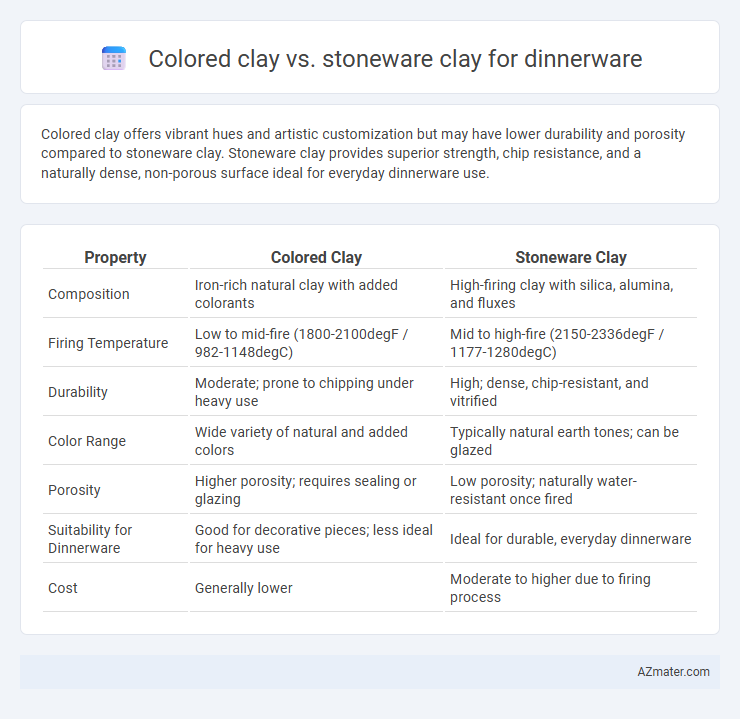Colored clay offers vibrant hues and artistic customization but may have lower durability and porosity compared to stoneware clay. Stoneware clay provides superior strength, chip resistance, and a naturally dense, non-porous surface ideal for everyday dinnerware use.
Table of Comparison
| Property | Colored Clay | Stoneware Clay |
|---|---|---|
| Composition | Iron-rich natural clay with added colorants | High-firing clay with silica, alumina, and fluxes |
| Firing Temperature | Low to mid-fire (1800-2100degF / 982-1148degC) | Mid to high-fire (2150-2336degF / 1177-1280degC) |
| Durability | Moderate; prone to chipping under heavy use | High; dense, chip-resistant, and vitrified |
| Color Range | Wide variety of natural and added colors | Typically natural earth tones; can be glazed |
| Porosity | Higher porosity; requires sealing or glazing | Low porosity; naturally water-resistant once fired |
| Suitability for Dinnerware | Good for decorative pieces; less ideal for heavy use | Ideal for durable, everyday dinnerware |
| Cost | Generally lower | Moderate to higher due to firing process |
Introduction to Colored Clay and Stoneware Clay
Colored clay offers vibrant, naturally pigmented hues ideal for artistic dinnerware, enhancing visual appeal without additional glazing. Stoneware clay is a durable, high-fired material known for its strength, chip resistance, and non-porous surface, making it suitable for everyday dinnerware. Each clay type provides unique aesthetic and functional benefits, influencing choice based on design and usage preferences.
Key Characteristics of Colored Clay
Colored clay, distinguished by its natural pigmentation, offers unique aesthetic appeal and allows for versatile design options in dinnerware, including vibrant hues that do not require added glazes. Its porosity can vary but typically requires sealing to ensure durability and resistance to liquids, making it less vitrified compared to stoneware. Colored clay often features a softer texture and lower firing temperature, which can affect its strength and chip resistance compared to the dense, highly vitrified surface of stoneware clay.
Unique Qualities of Stoneware Clay
Stoneware clay is renowned for its durability, high-fired strength, and naturally non-porous surface, making it ideal for everyday dinnerware that resists chipping and moisture absorption. Unlike colored clay, which often requires multiple glaze layers to achieve color depth and durability, stoneware's natural iron content provides a warm, earthy hue that enhances rustic and artisanal tableware aesthetics. Its excellent thermal shock resistance ensures stoneware pieces are safe for microwave and oven use, offering practical functionality alongside sophisticated design.
Aesthetic Differences in Finished Dinnerware
Colored clay offers vibrant tones and unique natural hues that enhance the visual appeal of dinnerware with varied textures and earthy finishes, creating a rustic or artisanal charm. Stoneware clay typically produces more uniform, smooth surfaces with subtle, muted colors, emphasizing durability and a classic, understated elegance in the final pieces. The aesthetic differences influence design choices, where colored clay suits bold, creative table settings and stoneware complements minimalist or traditional decor styles.
Durability and Strength Comparison
Stoneware clay offers superior durability and strength compared to colored clay, making it ideal for everyday dinnerware that withstands heavy use and frequent washing. Its dense, vitrified body resists chipping, cracking, and thermal shock better than most colored clays, which may be more prone to wear due to their varied compositions and surface treatments. Stoneware's robust physical properties ensure long-lasting performance, while colored clay often prioritizes aesthetic versatility over structural toughness.
Safety and Food Compatibility
Colored clay, often containing added pigments and minerals, must be thoroughly tested for lead and heavy metal leachability to ensure safety for dinnerware use. Stoneware clay, fired at high temperatures around 1200-1300degC, creates a dense, non-porous surface that naturally resists absorption and reduces contamination risks, making it highly food-compatible. Proper glazing with food-safe finishes is essential in both clays to prevent toxin transfer and maintain hygienic dinnerware standards.
Workability and Crafting Process
Colored clay offers enhanced workability due to its smoother texture and consistent plasticity, allowing for intricate detailing and easier shaping during the crafting process. Stoneware clay, though less pliable, provides superior durability and strength after firing, making it ideal for functional dinnerware that withstands daily use. Artisans often prefer colored clay for decorative pieces, while stoneware clay is favored for robust, practical dinnerware production.
Glazing and Firing Considerations
Colored clay often requires specific glaze formulations to prevent color bleeding and maintain vibrancy during firing, while stoneware clay's dense composition allows for a wider range of glaze compatibilities and higher firing temperatures typically between 1200degC to 1300degC. Stoneware's durability after vitrification makes it ideal for dinnerware subjected to regular use and dishwasher exposure, whereas colored clay may need lower bisque firing temperatures around bisque firing (900degC to 1000degC) to preserve its pigmentation before glaze application. Understanding the thermal expansion coefficients of both clay types is crucial to avoid glaze crazing or peeling, ensuring a functional and aesthetically pleasing finish.
Cost and Accessibility
Colored clay generally costs more than stoneware clay due to the added pigments and specialized processing required, making it less accessible for large-scale dinnerware production. Stoneware clay offers greater affordability and availability, often sourced from widespread deposits, which lowers material expenses and enhances accessibility for both hobbyists and commercial potters. The choice between the two impacts budget considerations, with stoneware being the more economical option for durable, everyday dinnerware.
Which Clay is Best for Your Dinnerware?
Colored clay offers vibrant hues and natural pigmentation, making it ideal for uniquely designed dinnerware with artistic appeal. Stoneware clay provides durability, chip resistance, and high firing strength, ensuring long-lasting, functional dinnerware suitable for daily use. For best dinnerware, stoneware clay is preferred for its strength and practical benefits, while colored clay is chosen for aesthetic customization and creative expression.

Infographic: Colored clay vs Stoneware clay for Dinnerware
 azmater.com
azmater.com